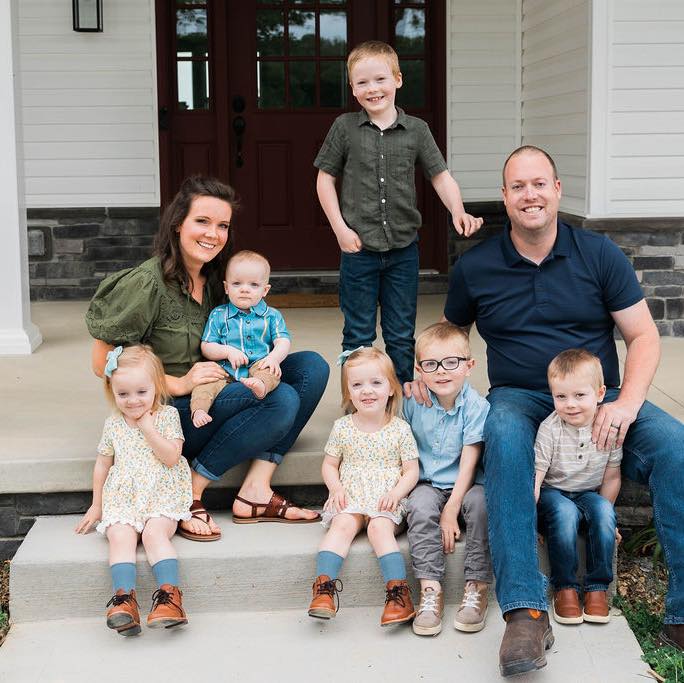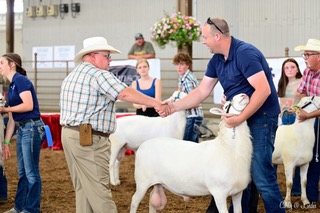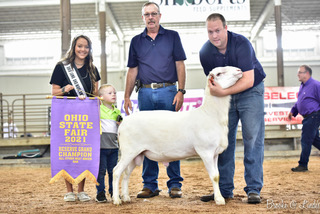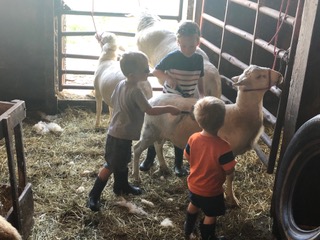Growing up in 4H, Daniel Ulry is a shepherd who has dabbled in many areas of the sheep industry. His experience spans three decades and many different management styles, as well as breeds of sheep. In the club lamb business, his family takes pride in a large meaty carcass with an eye appealing look for the show ring. Currently Dan has modified that traditional approach pairing it with data and EBVs to raise production oriented, easy keeping Katahdin sheep. He also runs a small herd of beef cattle that they graze with the sheep.

Dan runs Ulry Farms in Eastern Ohio with his wife Marta and their six children. These last two years the farm moved from his family’s farm, where he had 20 acres of pasture and access to neighbors’ hay fields. They are now on Marta’s family farm where there is access to more pasture for the sheep and cattle to harvest the grass themselves. Between leased and owned fields, Dan and Marta are managing close to 200 acres on their new property. They had to start from scratch in 2023 and built their house, livestock and hay barn (102 ft x 120 ft), and equipment shed/shop. What fences still existed were in disrepair or rotted away. They benefited from tax savings due to a 1031 ‘like-kind’ exchange, which helped them buy land and build their farm structures. They currently run 130 ewes and 30 head of cattle on the new property. For his day job, Dan works for FCX Performance an industrial distributor selling valves, pressure gauges, and pumps for a range of process flow control applications.
The farm transition has brought new challenges. The sheep had been in the barn since the move in November 2023 which was due to no existing fences. They applied for and had to wait for approval to receive funds from NRCS (National Resource Conservation Service) to cost share on building fence and water infrastructure, and to convert crop fields into pasture. It was a huge learning curve to manage the flock in confinement. Dan utilized Advantage 3-in-1 feeders year-round. Ewes got 1/2-1 lb feed each day in addition to the hay, fed free choice, from round bales. Feeding with a bucket twice a day caused spikes in their Rumen PH and causes more stress on the animals at feeding time. The 3-in-1 feeders minimized or eliminated these problems and made chores easier. However, it takes some practice to adjust the feeders and get them just right. “When we began using them, animals would overeat at the feeder during the adjustment period, then diarrhea and acidosis became a problem”. When first setting the feeder up and getting sheep trained to them, it is important to move slowly. The ewes finally got back out on pasture in June this year and it was a beautiful sight to have sheep on grass again.

Their business started out being focused on commercial sheep in 2011 with Katahdin-Dorper cross ewes; they built the flock up to lamb 60-70 ewes, then selling finished butcher lambs and commercial breeding stock. They also added some Dorset and Polypay ewes but decided that they were nowhere near as good of ewes as the hair sheep were; they were too much work and the shearing was an added cost. The Dorpers had strong early growth for the hot house lamb market. However, Dan was frustrated that, “their growth would stall out at 80 lbs and their final weights didn’t reach much higher than 100-110lbs months later.” In 2018, the wool sheep left, and they bought their first registered Katahdins to take the farm in the desired direction. Dan wanted to raise lambs to higher weights (130-150 lbs) because the butcher charged per head. It made more financial sense to butcher heavier lambs, and they were preferred by their main customers; Katahdins provided the extra growth and frame without needing to go to wool sheep.
Dan’s ideal size for his Katahdin ewes is 150-165lbs. He favors high post-weaning weights for a fast-growing lamb with a larger carcass weight. From his early days in the club lamb business, a larger robust animal is more desirable. He prioritizes easy keeping ewes, who have twins consistently. He is not opposed to “smaller frame ewes who flesh out well and weans her weight or more in lambs”. Using EBVs he is now selecting for increased lambing rates and milk while also wanting to add proven parasite resistance.

Ulry Farms has been in NSIP for 3 years. They started doing genomic testing on all sheep in 2023 and will have tested all registered ewes and rams by fall of 2025. They have utilized both NSIP and non-NSIP rams and plan to continue this moving forward. Dan feels that “using genetic testing helps us to prove out sheep, even when using rams with no individual data and that lack pedigree connections.” Dan really likes good phenotype, so he feels that this helps to blend both worlds and tries to find new genetic lines to bring into NSIP.
Rams go in with the ewes for 45 days during breeding season. In the past he has bred the ewe lambs at the end of the window to give them extra time for growth prior to his traditional January/ February lambing time. This past year he waited to breed the ewe lambs so they will lamb at 18 months old in the fall. Moving forward, he thinks putting the ewe lambs in to breed earlier or at the beginning of the lambing season would be helpful; he will have more energy to help those new mothers versus the end of lambing when there are other spring preparations beginning.
Currently, Ulry Farms primarily sells ewes and rams for breeding. Dan sold cuts and butcher lambs through a farmers’ market and at a local butcher from his previous farm, but now many non-breeding quality animals are headed to JDC Livestock or Mt. Hope, as they get set up at the new farm. Some ram lambs have been turned into teaser rams that are then sold to club lamb producers for AI and ET work, and commercial producers who want to tighten up lambing groups.
Dan likes to continually improve his system with new ideas. He would like to start lambing twice each year – in the fall and the spring. Artificial Insemination (AI) was added to the plan for fall lambs this year and was successful with a 67% conception rate. Beginning to collect Fecal Egg Counts is in his future also. Knowing that regular deworming isn’t sustainable, he wants to take advantage of increasing the overall immunity, which is being studied in the sheep world right now, in connection to proven parasite resistance. Dan is looking into an artificial dose of parasites to challenge lambs.

For new shepherds, Dan suggests finding a mentor to ask questions. Attending sheep events locally and regionally has really helped him to learn and meet others who are very knowledgeable and passionate about sheep. Networking and meeting people has taught him so much and been a valuable resource. He suggests, “Figure out what you want to do in the beginning and take gradual steps to make changes.”
Dan is proud of selling starter flocks to new shepherds. He loves to teach them from his years of experience in the sheep industry and see others get excited for the breed. He and Marta have six children ranging from 2- 8 yrs old: Floyd, Eustace, Orville, Mildred, Millicent, and Cecil. “The automatic gate openers Marta gifted me starting eight years ago have really been coming in handy”. The kids enjoy “helping out Dad” to work the sheep and feed, most of the time.
Daniel keeps a busy schedule with his family, livestock, day job and church. He is excited about unifying the show ring and NSIP using sound production data and genomics. Next summer his oldest son Floyd will be able to start showing their Katahdins through 4H. Dan looks forward to teaching the next generation how to raise some award-winning sheep.
By: Beckie Hotz, EAPK Communications Committee
![]()

